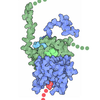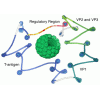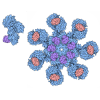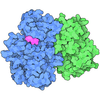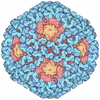+ データを開く
データを開く
- 基本情報
基本情報
| 登録情報 | データベース: PDB / ID: 5g04 | ||||||
|---|---|---|---|---|---|---|---|
| タイトル | Structure of the human APC-Cdc20-Hsl1 complex | ||||||
 要素 要素 |
| ||||||
 キーワード キーワード | CELL CYCLE / PHOSPHORYLATION / MITOSIS / UBIQUITINATION | ||||||
| 機能・相同性 |  機能・相同性情報 機能・相同性情報negative regulation of diacylglycerol biosynthetic process / protein localization to septin ring / mitotic morphogenesis checkpoint signaling / cellular bud neck septin ring / metaphase/anaphase transition of cell cycle / metaphase/anaphase transition of meiosis I / Inhibition of the proteolytic activity of APC/C required for the onset of anaphase by mitotic spindle checkpoint components / mitotic checkpoint complex / positive regulation of anaphase-promoting complex-dependent catabolic process / regulation of meiotic nuclear division ...negative regulation of diacylglycerol biosynthetic process / protein localization to septin ring / mitotic morphogenesis checkpoint signaling / cellular bud neck septin ring / metaphase/anaphase transition of cell cycle / metaphase/anaphase transition of meiosis I / Inhibition of the proteolytic activity of APC/C required for the onset of anaphase by mitotic spindle checkpoint components / mitotic checkpoint complex / positive regulation of anaphase-promoting complex-dependent catabolic process / regulation of meiotic nuclear division / positive regulation of synapse maturation / Conversion from APC/C:Cdc20 to APC/C:Cdh1 in late anaphase / regulation of mitotic cell cycle spindle assembly checkpoint / regulation of dendrite development / Inactivation of APC/C via direct inhibition of the APC/C complex / APC/C:Cdc20 mediated degradation of mitotic proteins / positive regulation of synaptic plasticity / Phosphorylation of Emi1 / anaphase-promoting complex / Aberrant regulation of mitotic exit in cancer due to RB1 defects / protein branched polyubiquitination / metaphase/anaphase transition of mitotic cell cycle / regulation of meiotic cell cycle / anaphase-promoting complex-dependent catabolic process / Phosphorylation of the APC/C / anaphase-promoting complex binding / regulation of exit from mitosis / cellular bud neck / positive regulation of mitotic metaphase/anaphase transition / positive regulation of dendrite morphogenesis / positive regulation of ubiquitin protein ligase activity / ubiquitin ligase activator activity / protein K11-linked ubiquitination / regulation of mitotic metaphase/anaphase transition / mitotic sister chromatid cohesion / ubiquitin-ubiquitin ligase activity / mitotic metaphase chromosome alignment / mitotic spindle assembly checkpoint signaling / Regulation of APC/C activators between G1/S and early anaphase / cullin family protein binding / Transcriptional Regulation by VENTX / mitotic spindle assembly / enzyme-substrate adaptor activity / APC/C:Cdc20 mediated degradation of Cyclin B / ubiquitin-like ligase-substrate adaptor activity / positive regulation of axon extension / APC-Cdc20 mediated degradation of Nek2A / protein K48-linked ubiquitination / heterochromatin / intercellular bridge / Amplification of signal from unattached kinetochores via a MAD2 inhibitory signal / Mitotic Prometaphase / EML4 and NUDC in mitotic spindle formation / Autodegradation of Cdh1 by Cdh1:APC/C / APC/C:Cdc20 mediated degradation of Securin / nuclear periphery / SCF-beta-TrCP mediated degradation of Emi1 / regulation of mitotic cell cycle / Resolution of Sister Chromatid Cohesion / Assembly of the pre-replicative complex / Cdc20:Phospho-APC/C mediated degradation of Cyclin A / APC/C:Cdh1 mediated degradation of Cdc20 and other APC/C:Cdh1 targeted proteins in late mitosis/early G1 / protein catabolic process / RHO GTPases Activate Formins / CDK-mediated phosphorylation and removal of Cdc6 / G protein-coupled receptor binding / brain development / kinetochore / spindle / G2/M transition of mitotic cell cycle / histone deacetylase binding / Separation of Sister Chromatids / spindle pole / neuron projection development / ubiquitin-protein transferase activity / mitotic spindle / Antigen processing: Ubiquitination & Proteasome degradation / ubiquitin protein ligase activity / nervous system development / mitotic cell cycle / Senescence-Associated Secretory Phenotype (SASP) / microtubule cytoskeleton / ubiquitin-dependent protein catabolic process / protein phosphatase binding / molecular adaptor activity / cell differentiation / Ub-specific processing proteases / non-specific serine/threonine protein kinase / protein ubiquitination / protein kinase activity / regulation of cell cycle / negative regulation of gene expression / cell division / protein serine kinase activity / intracellular membrane-bounded organelle / protein serine/threonine kinase activity / positive regulation of cell population proliferation / ubiquitin protein ligase binding / centrosome / nucleolus 類似検索 - 分子機能 | ||||||
| 生物種 |  HOMO SAPIENS (ヒト) HOMO SAPIENS (ヒト) | ||||||
| 手法 | 電子顕微鏡法 / 単粒子再構成法 / クライオ電子顕微鏡法 / 解像度: 3.9 Å | ||||||
 データ登録者 データ登録者 | Zhang, S. / Chang, L. / Alfieri, C. / Zhang, Z. / Yang, J. / Maslen, S. / Skehel, M. / Barford, D. | ||||||
 引用 引用 |  ジャーナル: Nature / 年: 2016 ジャーナル: Nature / 年: 2016タイトル: Molecular mechanism of APC/C activation by mitotic phosphorylation. 著者: Suyang Zhang / Leifu Chang / Claudio Alfieri / Ziguo Zhang / Jing Yang / Sarah Maslen / Mark Skehel / David Barford /  要旨: In eukaryotes, the anaphase-promoting complex (APC/C, also known as the cyclosome) regulates the ubiquitin-dependent proteolysis of specific cell-cycle proteins to coordinate chromosome segregation ...In eukaryotes, the anaphase-promoting complex (APC/C, also known as the cyclosome) regulates the ubiquitin-dependent proteolysis of specific cell-cycle proteins to coordinate chromosome segregation in mitosis and entry into the G1 phase. The catalytic activity of the APC/C and its ability to specify the destruction of particular proteins at different phases of the cell cycle are controlled by its interaction with two structurally related coactivator subunits, Cdc20 and Cdh1. Coactivators recognize substrate degrons, and enhance the affinity of the APC/C for its cognate E2 (refs 4-6). During mitosis, cyclin-dependent kinase (Cdk) and polo-like kinase (Plk) control Cdc20- and Cdh1-mediated activation of the APC/C. Hyperphosphorylation of APC/C subunits, notably Apc1 and Apc3, is required for Cdc20 to activate the APC/C, whereas phosphorylation of Cdh1 prevents its association with the APC/C. Since both coactivators associate with the APC/C through their common C-box and Ile-Arg tail motifs, the mechanism underlying this differential regulation is unclear, as is the role of specific APC/C phosphorylation sites. Here, using cryo-electron microscopy and biochemical analysis, we define the molecular basis of how phosphorylation of human APC/C allows for its control by Cdc20. An auto-inhibitory segment of Apc1 acts as a molecular switch that in apo unphosphorylated APC/C interacts with the C-box binding site and obstructs engagement of Cdc20. Phosphorylation of the auto-inhibitory segment displaces it from the C-box-binding site. Efficient phosphorylation of the auto-inhibitory segment, and thus relief of auto-inhibition, requires the recruitment of Cdk-cyclin in complex with a Cdk regulatory subunit (Cks) to a hyperphosphorylated loop of Apc3. We also find that the small-molecule inhibitor, tosyl-l-arginine methyl ester, preferentially suppresses APC/C(Cdc20) rather than APC/C(Cdh1), and interacts with the binding sites of both the C-box and Ile-Arg tail motifs. Our results reveal the mechanism for the regulation of mitotic APC/C by phosphorylation and provide a rationale for the development of selective inhibitors of this state. | ||||||
| 履歴 |
|
- 構造の表示
構造の表示
| ムービー |
 ムービービューア ムービービューア |
|---|---|
| 構造ビューア | 分子:  Molmil Molmil Jmol/JSmol Jmol/JSmol |
- ダウンロードとリンク
ダウンロードとリンク
- ダウンロード
ダウンロード
| PDBx/mmCIF形式 |  5g04.cif.gz 5g04.cif.gz | 1.6 MB | 表示 |  PDBx/mmCIF形式 PDBx/mmCIF形式 |
|---|---|---|---|---|
| PDB形式 |  pdb5g04.ent.gz pdb5g04.ent.gz | 1.3 MB | 表示 |  PDB形式 PDB形式 |
| PDBx/mmJSON形式 |  5g04.json.gz 5g04.json.gz | ツリー表示 |  PDBx/mmJSON形式 PDBx/mmJSON形式 | |
| その他 |  その他のダウンロード その他のダウンロード |
-検証レポート
| 文書・要旨 |  5g04_validation.pdf.gz 5g04_validation.pdf.gz | 1 MB | 表示 |  wwPDB検証レポート wwPDB検証レポート |
|---|---|---|---|---|
| 文書・詳細版 |  5g04_full_validation.pdf.gz 5g04_full_validation.pdf.gz | 1.3 MB | 表示 | |
| XML形式データ |  5g04_validation.xml.gz 5g04_validation.xml.gz | 224.4 KB | 表示 | |
| CIF形式データ |  5g04_validation.cif.gz 5g04_validation.cif.gz | 340.2 KB | 表示 | |
| アーカイブディレクトリ |  https://data.pdbj.org/pub/pdb/validation_reports/g0/5g04 https://data.pdbj.org/pub/pdb/validation_reports/g0/5g04 ftp://data.pdbj.org/pub/pdb/validation_reports/g0/5g04 ftp://data.pdbj.org/pub/pdb/validation_reports/g0/5g04 | HTTPS FTP |
-関連構造データ
- リンク
リンク
- 集合体
集合体
| 登録構造単位 | 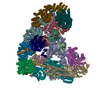
|
|---|---|
| 1 |
|
- 要素
要素
-ANAPHASE-PROMOTING COMPLEX SUBUNIT ... , 11種, 13分子 ABDEGWILMNOXY
| #1: タンパク質 | 分子量: 216725.469 Da / 分子数: 1 / 由来タイプ: 組換発現 / 由来: (組換発現)  HOMO SAPIENS (ヒト) / プラスミド: PF1, PU1 HOMO SAPIENS (ヒト) / プラスミド: PF1, PU1発現宿主:  参照: UniProt: Q9H1A4 | ||||||||||||
|---|---|---|---|---|---|---|---|---|---|---|---|---|---|
| #2: タンパク質 | 分子量: 9854.647 Da / 分子数: 1 / 由来タイプ: 組換発現 / 由来: (組換発現)  HOMO SAPIENS (ヒト) / プラスミド: PF1, PU1 HOMO SAPIENS (ヒト) / プラスミド: PF1, PU1発現宿主:  参照: UniProt: Q9NYG5 | ||||||||||||
| #4: タンパク質 | 分子量: 14286.727 Da / 分子数: 1 / 由来タイプ: 組換発現 / 由来: (組換発現)  HOMO SAPIENS (ヒト) / プラスミド: PF1, PU1 HOMO SAPIENS (ヒト) / プラスミド: PF1, PU1発現宿主:  参照: UniProt: P60006 | ||||||||||||
| #5: タンパク質 | 分子量: 11677.995 Da / 分子数: 1 / 由来タイプ: 組換発現 / 由来: (組換発現)  HOMO SAPIENS (ヒト) / プラスミド: PF1, PU1 HOMO SAPIENS (ヒト) / プラスミド: PF1, PU1発現宿主:  参照: UniProt: Q96DE5 | ||||||||||||
| #7: タンパク質 | 分子量: 9793.999 Da / 分子数: 2 / 由来タイプ: 組換発現 / 由来: (組換発現)  HOMO SAPIENS (ヒト) / プラスミド: PF1, PU1 HOMO SAPIENS (ヒト) / プラスミド: PF1, PU1発現宿主:  参照: UniProt: Q8NHZ8 #8: タンパク質 | | 分子量: 92219.227 Da / 分子数: 1 / 由来タイプ: 組換発現 / 由来: (組換発現)  HOMO SAPIENS (ヒト) / プラスミド: PF1, PU1 HOMO SAPIENS (ヒト) / プラスミド: PF1, PU1発現宿主:  参照: UniProt: Q9UJX5 #10: タンパク質 | | 分子量: 21124.949 Da / 分子数: 1 / 由来タイプ: 組換発現 / 由来: (組換発現)  HOMO SAPIENS (ヒト) / プラスミド: PF1, PU1 HOMO SAPIENS (ヒト) / プラスミド: PF1, PU1発現宿主:  参照: UniProt: Q9UM13 #11: タンパク質 | | 分子量: 8528.309 Da / 分子数: 1 / 由来タイプ: 組換発現 / 由来: (組換発現)  HOMO SAPIENS (ヒト) / プラスミド: PF1, PU1 HOMO SAPIENS (ヒト) / プラスミド: PF1, PU1発現宿主:  参照: UniProt: Q9BS18 #12: タンパク質 | | 分子量: 93938.977 Da / 分子数: 1 / 由来タイプ: 組換発現 / 由来: (組換発現)  HOMO SAPIENS (ヒト) / プラスミド: PF1, PU1 HOMO SAPIENS (ヒト) / プラスミド: PF1, PU1発現宿主:  参照: UniProt: Q9UJX6 #13: タンパク質 | | 分子量: 85179.766 Da / 分子数: 1 / 由来タイプ: 組換発現 / 由来: (組換発現)  HOMO SAPIENS (ヒト) / プラスミド: PF1, PU1 HOMO SAPIENS (ヒト) / プラスミド: PF1, PU1発現宿主:  参照: UniProt: Q9UJX4 #16: タンパク質 | 分子量: 66929.367 Da / 分子数: 2 / 由来タイプ: 組換発現 / 由来: (組換発現)  HOMO SAPIENS (ヒト) / プラスミド: PF1, PU1 HOMO SAPIENS (ヒト) / プラスミド: PF1, PU1発現宿主:  参照: UniProt: Q9UJX3 |
-CELL DIVISION CYCLE PROTEIN ... , 4種, 7分子 CPFHJKR
| #3: タンパク質 | 分子量: 68921.031 Da / 分子数: 2 / 由来タイプ: 組換発現 / 由来: (組換発現)  HOMO SAPIENS (ヒト) / プラスミド: PF1, PU1 HOMO SAPIENS (ヒト) / プラスミド: PF1, PU1発現宿主:  参照: UniProt: Q9UJX2 #6: タンパク質 | 分子量: 91973.125 Da / 分子数: 2 / 由来タイプ: 組換発現 / 由来: (組換発現)  HOMO SAPIENS (ヒト) / プラスミド: PF1, PU1 HOMO SAPIENS (ヒト) / プラスミド: PF1, PU1発現宿主:  参照: UniProt: P30260 #9: タンパク質 | 分子量: 71747.516 Da / 分子数: 2 / 由来タイプ: 組換発現 / 由来: (組換発現)  HOMO SAPIENS (ヒト) / プラスミド: PF1, PU1 HOMO SAPIENS (ヒト) / プラスミド: PF1, PU1発現宿主:  参照: UniProt: Q13042 #14: タンパク質 | | 分子量: 54796.508 Da / 分子数: 1 / 由来タイプ: 組換発現 / 由来: (組換発現)  HOMO SAPIENS (ヒト) / プラスミド: MODIFIED PFASTBAC HTA HOMO SAPIENS (ヒト) / プラスミド: MODIFIED PFASTBAC HTA発現宿主:  参照: UniProt: Q12834 |
|---|
-タンパク質 / 非ポリマー , 2種, 4分子 S

| #15: タンパク質 | 分子量: 23658.162 Da / 分子数: 1 / Fragment: RESIDUES 667-872 / 由来タイプ: 組換発現 由来: (組換発現)  プラスミド: PET28A / 発現宿主:  参照: UniProt: P34244, non-specific serine/threonine protein kinase |
|---|---|
| #17: 化合物 |
-実験情報
-実験
| 実験 | 手法: 電子顕微鏡法 |
|---|---|
| EM実験 | 試料の集合状態: PARTICLE / 3次元再構成法: 単粒子再構成法 |
- 試料調製
試料調製
| 構成要素 | 名称: RECOMBINANT APC-CDC20- HSL1 COMPLEX / タイプ: COMPLEX |
|---|---|
| 緩衝液 | 名称: 20MM HEPES, 150MM NACL, 0. 5MM TCEP / pH: 8 / 詳細: 20MM HEPES, 150MM NACL, 0. 5MM TCEP |
| 試料 | 濃度: 0.15 mg/ml / 包埋: NO / シャドウイング: NO / 染色: NO / 凍結: YES |
| 試料支持 | 詳細: CARBON |
| 急速凍結 | 装置: FEI VITROBOT MARK III / 凍結剤: ETHANE / 詳細: LIQUID ETHANE |
- 電子顕微鏡撮影
電子顕微鏡撮影
| 実験機器 | 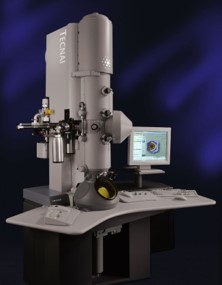 モデル: Tecnai Polara / 画像提供: FEI Company |
|---|---|
| 顕微鏡 | モデル: FEI POLARA 300 / 日付: 2015年10月30日 |
| 電子銃 | 電子線源:  FIELD EMISSION GUN / 加速電圧: 300 kV / 照射モード: FLOOD BEAM FIELD EMISSION GUN / 加速電圧: 300 kV / 照射モード: FLOOD BEAM |
| 電子レンズ | モード: BRIGHT FIELD / 倍率(公称値): 78000 X / 倍率(補正後): 78000 X / 最大 デフォーカス(公称値): 4000 nm / 最小 デフォーカス(公称値): 2000 nm / Cs: 2 mm |
| 試料ホルダ | 温度: 100 K |
| 撮影 | 電子線照射量: 27 e/Å2 フィルム・検出器のモデル: FEI FALCON II (4k x 4k) |
- 解析
解析
| 対称性 | 点対称性: C1 (非対称) | ||||||||||||
|---|---|---|---|---|---|---|---|---|---|---|---|---|---|
| 3次元再構成 | 解像度: 3.9 Å / 解像度の算出法: FSC 0.143 CUT-OFF / 粒子像の数: 179660 / Refinement type: HALF-MAPS REFINED INDEPENDENTLY / 対称性のタイプ: POINT | ||||||||||||
| 精密化 | 最高解像度: 3.9 Å | ||||||||||||
| 精密化ステップ | サイクル: LAST / 最高解像度: 4 Å
|
 ムービー
ムービー コントローラー
コントローラー













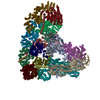






 PDBj
PDBj

